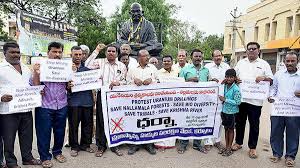22 September 2025 The Hindu Editorial
What to Read in The Hindu Editorial( Topic and Syllabus wise)
Editorial 1: Uranium unrest
Context
People’s consent must be central to any resource extraction project.
Introduction
The Centre’s decision to push uranium mining in Meghalaya, despite decades of Khasi resistance, highlights tensions between national resource strategies and tribal rights. By bypassing public consultations through executive orders, the government risks undermining democratic safeguards. Past experiences in Jharkhand show how communities bear environmental, health, and livelihood costs while their voices remain marginalised in decision-making.
Centre’s Uranium Mining Push in Meghalaya
- Troubling Precedent in Resource Extraction
- The Centre’s insistence on uranium mining in Meghalaya, despite failed talks with local leaders, sets a disturbing benchmark in India’s resource policy.
- Khasi groups have resisted mining at Domiasiat and Wahkaji since the 1980s.
- Exemption from Public Consultation
- The Union Environment Ministry recently issued an Office Memorandum (OM)exempting atomic, critical, and strategic mineral mining from public consultations.
- Local organisations have strongly opposed this move, warning of weakened procedural safeguards.
- A group aligned with the ruling party urged the Khasi Hills Autonomous District Council to invoke its Sixth Schedule powersto defend tribal rights.
- OMs, being executive instruments, lack independent scrutiny and risk reducing communities to passive bystanders.
- Past Experiences with Uranium Mining
- Uranium Corporation of India Limited has operated in Singhbhum, Jharkhandfor decades.
- Expansion proposals triggered protests over radiation exposure, livelihood loss, and disregard for objections.
- Villagers allege notices were issued in unfamiliar languages, sidelining genuine participation.
- These experiences reinforce the tribal perception that their land is treated as a “resource frontier”for the rest of India.
Democratic Safeguards and Tribal Consent
- Failure to Respect Local Opposition
- The Centre’s stance signals that local refusal is no longer respected.
- Uranium mining is highly polluting and causes irreversible ecological damage.
- Importance of Free, Prior, and Informed Consent
- Global norms demand free, prior, and informed consent (FPIC)before initiating such projects.
- If consent is absent, the state must reconsider uranium as the only path to security or development.
- Alternatives could include exploring other deposits, substitutes, or power-generation strategies.
The Way Forward
- Legal and Constitutional Remedies
- Communities may challenge the OM’s validity in court.
- They can invoke constitutional protections under the Fifth and Sixth Schedulesand rely on precedents like the Niyamgiri judgment (2013).
- Withdrawal of the OM
- The Ministry should revoke the OM, as exempting multiple minerals from consultation undermines mining governance nationwide.
- Dialogue Over Coercion
- If protests intensify, the Centre should prioritise dialogue, not coercion.
- Coercive action may secure short-term compliance but will fuel long-term resentment.
- The government is duty-bound to ensure constitutional protections are upheld in practice.
Conclusion
Uranium mining without local consent erodes trust, threatens ecosystems, and undermines constitutional protections. Sustainable development requires respecting tribal autonomy through dialogue and free, prior, informed consent (FPIC). Instead of coercion, the state must pursue alternatives—other energy sources, substitutes, or deposits—and ensure democratic rights are upheld. Withdrawal of the Office Memorandum (OM) is essential to protect justice and inclusive governance.
Editorial 2: H-1B, maybe
Context
India’s tech workforce must diversify beyond U.S. employment opportunities.
Introduction
President Donald Trump’s H-1B visa fee hike to $100,000 has raised concerns over humanitarian consequences for Indian tech workers and potential disruption in U.S. tech companies. With Indian nationals forming the majority of visa recipients, the policy threatens talent mobility, innovation, and economic collaboration, highlighting the challenges posed by protectionist measures on global skilled workforce exchanges.
H-1B Fee Hike and Immediate Impact
- President Donald Trumpraised the H-1B visa fee for new applicants to $100,000, nearly six times the previous rate.
- Humanitarian consequences: Tens of thousands of potential applicants and their families could be adversely affected (MEA concern).
- Disruption to U.S. tech companies: Companies relying on highly skilled foreign workers may face talent shortages.
- Visa trends:
- Annual cap: 85,000 visas(since 2004), allocated via lottery.
- Applications for FY dropped to ~3,59,000(four-year low).
- Indian nationals account for 71%, with 60% earning less than $100,000.
Diplomatic Response and Challenges
- India’s MEAemphasized the role of skilled talent mobility in fostering innovation, economic growth, and competitiveness in both countries.
- Limited scope for diplomatic or political pressureto reverse the U.S. policy.
- Long-term implication: Employers may struggle to justify hiring specialized foreign workersat the increased fee.
Domestic Opportunities and Long-Term Strategy
- India can mitigate falloutby:
- Strengthening domestic infrastructureand implementing reforms.
- Developing Artificial Intelligence (AI)and other advanced tech capabilities.
- Exploring new marketsin Asia (China, Russia) and parts of Europe.
- Need for a long-term strategyto reduce reliance on S. tech job opportunities.
- The U.S. risks a shortage of scientific and engineering talent, affecting its innovation and economic progress.
Conclusion
While the fee hike may temporarily affect Indian workers, proactive domestic reforms, investment in AI and technology, and exploration of alternative global markets can mitigate its impact. Reducing dependence on U.S. employment will strengthen India’s tech ecosystem, while the U.S. risks talent shortages, demonstrating the importance of sustainable global collaboration for innovation and economic growth.
![]()


